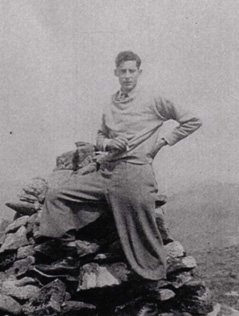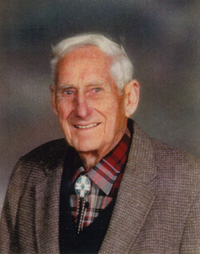Oxford PH404 - Beinn a Bhuird
|
There are several pages relating to the tragic loss of this aircraft. Use the menu below to navigate around from page to page. To return to the Home Page of this website click 'Home'.
|
| Home |
|
Last Flight
Lost then Found |
Discovery of a Watch |
|
Beinn a Bhuird
|
|
Oxford PH404 from 311 Squadron
The Last Flight. Lost then Found Squadron Leader Karel Kvapil - Pilot The aircraft failed to arrive at RAF Hornchurch, and no record could be found of it having landed at any other airbase. It was believed that Oxford PH404 must have crashed in the sea since no trace of any wreckage had been reported. It was not until August 19th 1945, that the fate of Oxford PH404 and her crew was finally known when the wreckage was discovered by two hill walkers.
The men who unwittingly found the aircraft were Dr James Bain, a teacher in Elgin, and Flight Lieutenant Archie Pennie who was in the RAF but who was at the time taking a few days leave at his mothers in Elgin. Long time friends and both keen hill walkers, they had decided to spend their Sunday climbing two mountains in the Cairngorms, namely Beinn a Bhuird (3924 ft / 1196 m) and neighbouring Ben Avon (3843 ft / 1171 m). They set out at mid morning from Inchrory, and on approaching the summit of Beinn a Bhuird they found some aircraft debris and soon afterwards part of a wing. Finally, they discovered the remains of the wreck of the Oxford PH404, and alarmingly the bodies of five airmen. The cockpit and tail section were reasonably intact. The engines were relatively undamaged, perhaps because the aircraft had fallen on snow. The yellow paint work on the aircraft suggested to Archie Pennie that it had been a training aircraft. The bodies of two airmen were located in the cockpit, two others lay outside amongst the debris. The saddest discovery of all was that of the body of the fifth airman. It was found inside the remains of the fuselage and it was clear that he had initially survived the crash. He was wearing several layers of clothing that he must have removed from his dead crewmates in an effort to combat the cold. He appeared to have suffered a serious head injury and had made himself a make-shift bandage for his head wound using a towel. It was clear to Dr Bain and Flt Lt Pennie that the crash had occurred some months previously owing to the condition of the bodies. They made a note of the aircrafts number and location and after descending the mountain went to Tomintoul and reported their discovery to the local police. They also reported the details to the local police in Elgin when they returned home. The following day, Monday 20th August, a recovery team including Police Officers and members of the RAF Mountain Rescue Team from RAF Dyce made their way from Tomintoul towards Beinn a Bhuird to attempt a recovery of the airmen. Local assistance in locating the crash site was provided by Captain D McNiven, proprietor of the Richmond Arms in Tomintoul, and Mr William Stewart, a farmer from Clashnoir, Glenlivet. A base for the recovery operation was set up near Inchrory. The Ambulance and transport wagons also waited at Inchrory as they were unable to travel any nearer the mountain due to the rough terrain.
By Monday night the recovery team on the mountain had removed the bodies from the wreckage and made efforts to prepare them for removal down the mountain. It was not possible to further progress with the recovery that night, and indeed some of the recovery team were in doubt as to whether it would be possible to remove the bodies down the mountain at all. They returned to the base near Inchrory to report on their difficulties and the NCO in charge of the party departed for RAF Dyce to inform them of the situation and to enquire about the possibility of burying the airmen on the mountain. However, the RAF authorities refused to permit a burial on the mountain and ordered that the bodies be brought down. To assist in bringing the bodies down mules from an Indian regiment based at Braemar were transported by road to Inchrory. It took ten days to complete the recovery operation with the recovery team working in a very remote location on steep, uneven and boulder strewn ground. The Mountain Rescue Team burnt the remains of the wreckage at the crash site to avoid it being mistaken for any other lost aircraft in the future. Only the engines and a few other small parts of the aircraft were not burnt. It was a gruelling operation for all the men involved. The bodies of the five airmen recovered from Oxford PH404 were taken by road to an Aberdeen mortuary and placed in coffins. From here they were taken by train to Brookwood Military Cemetery near Woking in Surrey. They were buried there on September 3rd 1945 in the Czechoslovak section of the cemetery. Acknowledgements: My thanks to Jim Hughes in Scotland, Pavel Vancata in the Czech Republic and Archie Pennie in Canada.
|
|||||||||||||||||||||||||||||||||||||
|
Visit to the crash site of Oxford PH404 in 2002
The Mission: To take photographs of the crash site of Oxford PH404 to send to the Czech Republic. The Date: 15th September 2002 The Team: Myself as Expedition Leader and James as Navigator. Having looked on paper (ie: maps) at the various options for tackling Beinn a Bhuird, we decided to approach the mountain from the Strathdon side rather than the Deeside side. This would involve a long walk in of ten miles, however, we could shorten the time taken for the walk in by doing it on mountain bikes as we knew the tracks were reasonable for biking. We set off from home bright and early in thick mist, but by the time we arrived at the start point for our mission the mist had cleared and it was a stunningly sunny September day with very little wind. Perfect! The cycle in took quite a while because it was such a beautiful day that we had to keep stopping to admire the view and the scenery (well those were some of the excuses for taking a rest!).
Finally, 10 miles later and a little saddle sore we dumped the bikes and started on the ascent of Beinn a Bhuird. The sun was still shining and so far we hadn't seen another soul.
The less said about the walk up the better I think! Suffice to say there was an abundance of stops for varying reasons - 'admiring the view', chocolate, checking the map, chocolate, sitting on rocks that looked like perfect stopping places (lots of those!), more chocolate, and so it went on...............
At long last we reached the area where we were expecting to be able to find some remaining wreckage from Oxford PH404. It took a while of hunting around the boulder strewn landscape before we finally located the site where the two Cheetah engines still sit along with other small bits of debris.
We spent a bit of time at the crash site and placed some wild flowers on one of the engines in memory of the five men who lost their lives in January 1945. On the day that we visited the crash site the sky was blue and the sun was shining, there was hardly a breath of wind, we were most fortunate. In January 1945 this area would have been a wild and desolate place with a thick covering of snow.
On reaching the bottom of the mountain and recovering our bikes we looked back up to see the mist starting to swirl over the tops. We had just made it down in time. The weather in the Scottish mountains can vary so much at any time of the year and it's possible to experience all four seasons all in one day.
After the long cycle out we reached the car just before dark after having spent 10 hours out in the mountains and having covered a distance of 26 miles (42 km). Exhausted, but very happy we made our way home via the Colquhonnie Hotel in Strathdon where a well earned drink was enjoyed - thanks John and Sally!
|
© Linzee Druce 2002-2012


